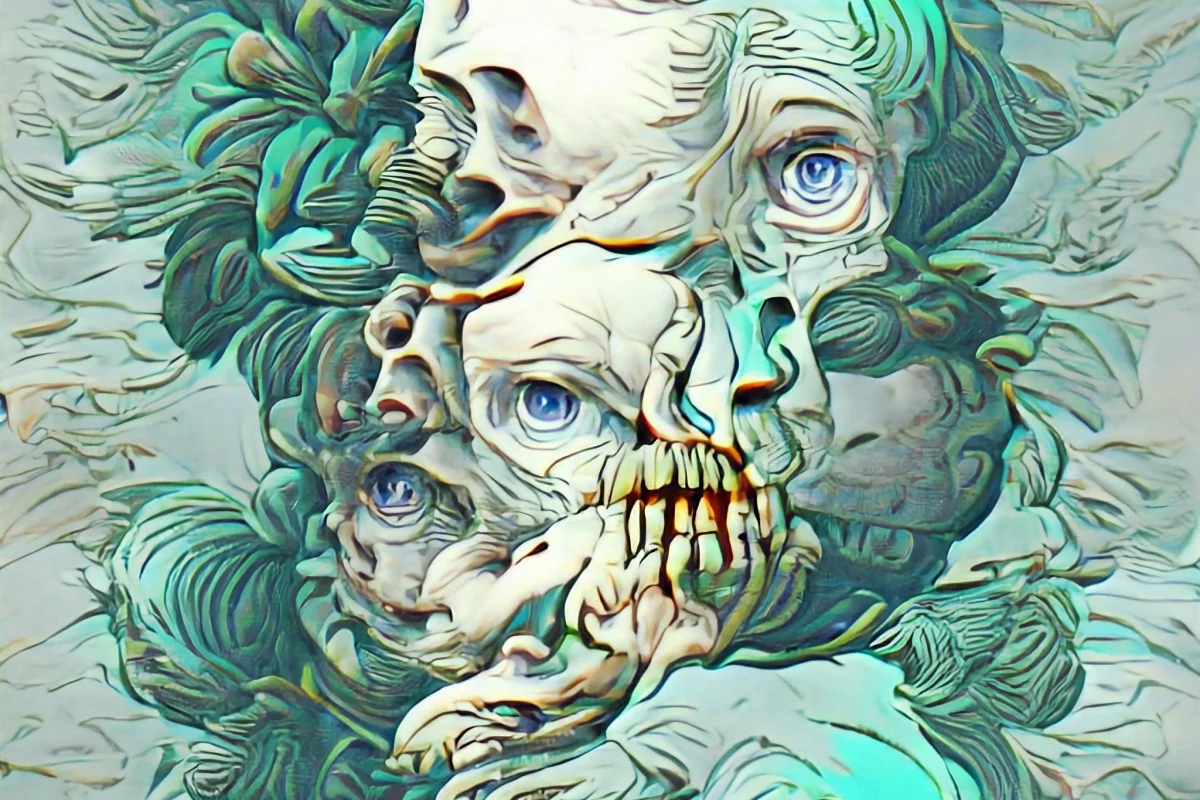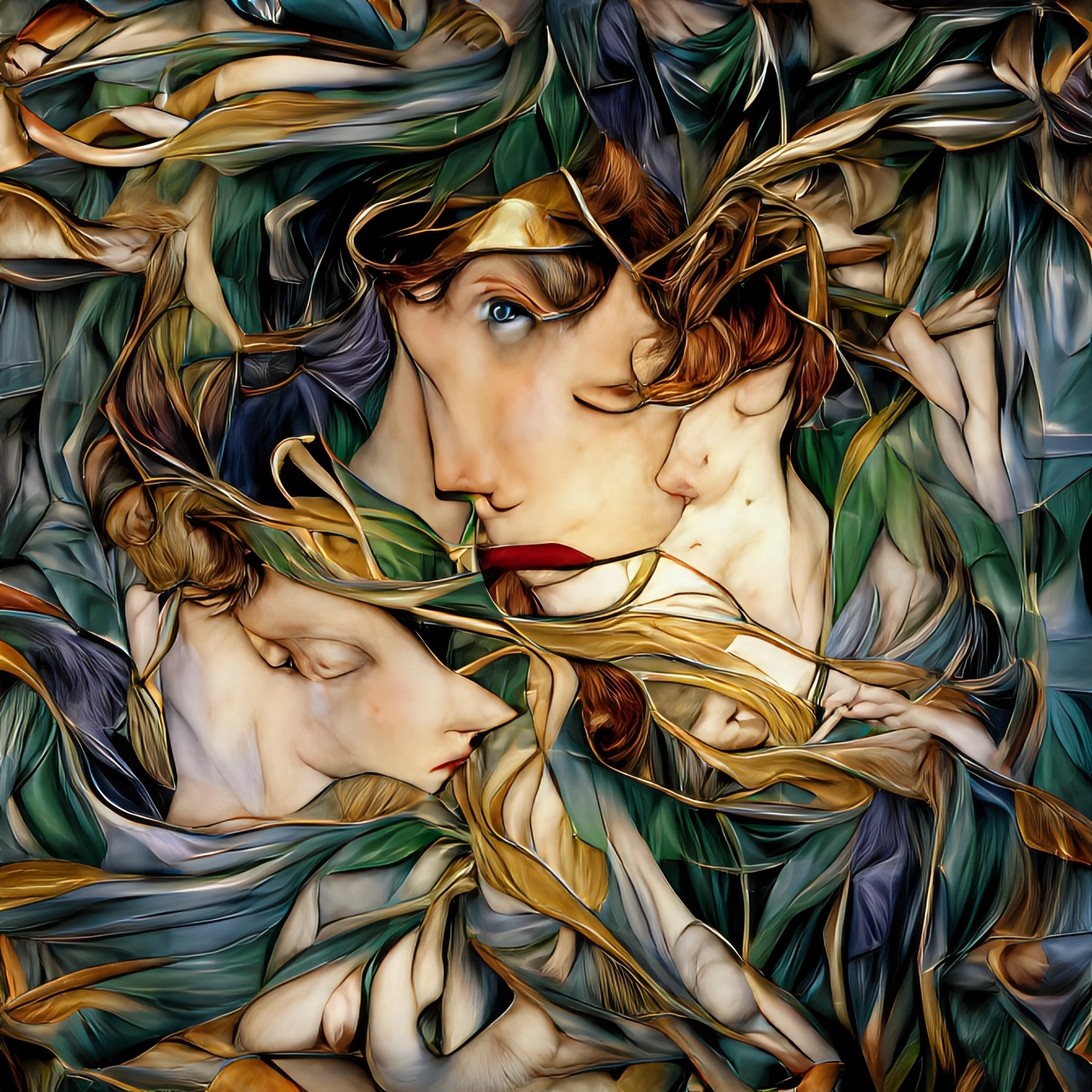An AI algorithm called Botto has made somewhere around US$1.3 million at auction for its first six NFT artworks. Botto generates thousands of images, and a community of humans vote to influence its direction and decide which pieces go to auction.
An AI artist, of course, has some serious advantages over its human counterparts. For starters, it can very quickly educate itself on the history of human visual expression by analyzing a massive trove of influences, cataloguing and remembering everything it's ever seen.
Where a human artist might slave away over a hot canvas or drawing tablet for days, even years, the AI can pound out its works in a matter of minutes. Algorithmic art might be derivative, it's true – but then the same can be said about the vast majority of human artists too.
Indeed, there's an argument to be made that the human brain itself operates as a kind of sticky organic algorithm, and that if we could pick apart its workings and understand the "source material" of a human life, it would be possible to predict a person's actions, including creative ones.
What computers can't do is have an opinion on whether their creations will strike a chord in the hearts and minds of human viewers. The Botto project is an attempt to outsource this part of the process, adding human discriminators to the growing artistic talents and efficiency of creative AI engines.
How Botto creates art
Thus, Botto goes away and does most of the hard yards by itself; it generates a random string of words and sentences, which it feeds into VQGAN (Vector Quantized Generative Adversarial Network). VQGAN uses the word string – plus its training algorithms and massive databases of prior artwork – to generate images.
A second piece of software called CLIP (Contrastive Language-Image Pre-training) decides how close this output is to representing the initial word string, and gets VQGAN to adjust its parameters until it meets a certain score. Once a final image is generated, CLIP also gets to choose its two-word title; random two-word combinations are fed into CLIP until it finds one that it believes resonates well with the content of the image.
Then it's time for a description, and for this, Botto recruits GPT-3, a powerful natural language generator from OpenAI, which comes out with 5-10 different pieces of abstract poetry. The core human team at Botto check these through – GPT-3 is trained on a wide array of internet content and thus "can be quite foul at times," so the human team picks a nice description, edits it for punctuation and typos, and the piece is done.
From 300 initial prompts a day, Botto generates 300 images. Then, a "taste model" selects 350 of these images each week to be thrown to the human masses. Thousands of Botto community members vote on the artworks put before them, and each week's winner is minted as an NFT and auctioned off on the SuperRare platform.
The human voting behavior is also used to train both the taste model that selects the final images for voting each week, and to "influence which aspects of text prompts are used" to generate the initial text strings to feed into the start of next week's process – although Botto is also designed to continually "challenge" its user base by presenting some pieces each week "with different characteristics from what has been presented to date."
So in theory, Botto's art should become more and more appealing to humans over time – although we have to admit, even its earliest Instagram posts are pretty dang cool to look at.
Who gets the money?
Thus far, six pieces have been auctioned off as NFTs. The first, Asymmetric Liberation, sold for around US$325,000. The second, Scene Precede, brought in around US$430,000. Things have dropped off somewhat since then, but the latest and cheapest work, Cross Adieu, still brought in somewhere around US$81,000.
What happens to that cash? Well, apart from SuperRare's 15 percent commission, effectively it's used to incentivize participation in the Botto project and the voting process. Botto has its own cryptocurrency token, built on the Ethereum blockchain using the ERC-20 governance token. In order to vote, users need to buy in, exchanging Ether for Botto tokens and "staking" them to be used by the Botto network. Owning a certain number of Botto tokens lets you vote a certain number of times per week.
When the project sells an artwork, the post-commission proceeds are used to buy Botto tokens and "burn" them – removing them from circulation by sending them to a wallet address that can't be accessed or used by anyone. The NFTs are designed such that any future sale will generate a 10 percent royalty back to the Botto project as well, which will also be used to buy and burn tokens.
Given that there's a restricted supply of Botto tokens, the hope here is that this burning process will gradually raise the value of the remaining tokens, so that anyone who buys in and participates will eventually be able to make some money selling their tokens for more than they paid for them. Mind you, "gas" prices you've got to pay on every single interaction with the Ethereum network have spiked so high lately that Botto's own "how-to" guide shows an example in which swapping US$35 worth of Ether for Botto tokens costs a total of US$93.12 once gas fees are added. Ouch!
Either way, the Botto project aims to generate cash as well as art that's interesting and valuable to humans. The voting process means there's some sort of consensus among thousands of art-loving crypto-gamblers that the piece presented for auction each week is of high quality, and perhaps that feeds into the value of the final NFT. The team certainly seems to be doing its part to promote the work, putting on exhibitions and so forth.
Perhaps, of course, the Botto team or some other invested entity is anonymously bidding the prices of these early works up as a marketing expense, betting that high prices will generate headlines and bring more stakers into the network, while inflating the perceived value of subsequent NFTs and pumping the value of the Botto token up along with it. This is not an accusation; these projects are just complex enough, even with the transparency provided by their blockchain foundation, to confuse – and as soon as crypto and the weirdness of NFTs get involved, it does start to feel like everyone's a high-tech Amway rep trying to draw your money in to float themselves higher.
Indeed, NFT art prices are still flat-out hilarious to pretty much anyone that's not either buying or selling them. The idea of getting involved in bidding wars over the ownership rights to screenshottable JPGs seems even crazier than the idea of cryptocurrencies did when they first started surfacing – and those have certainly managed to successfully draw people into their shared fiction. One positive is that NFTs offer a genuine revenue stream for digital artists, but in this case, nobody buying a Botto work can tell themselves they're feeding a tortured 26 year old somewhere in Greenwich Village.
Still, the intersection of art and big money has always been weird, and often been dodgy. In another sense, what matters is that Botto is making interesting and evocative art that sparks emotions and ideas in a human audience. You don't need to buy the NFT to enjoy these abstract, surreal images, and if the algorithm does what it says on the tin and continues to make more and more compelling art over time, well, a bit of extra beauty is usually a good thing.
And perhaps the most surprising news here for me is just how easy these generative art and text tools are to access and enjoy. So if none of Botto's work quite rings your bell, you can always roll your sleeves up and start adding your own creative filter to AI art.
Source: Botto











